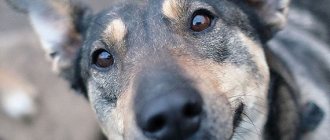Why do you need a veterinary passport?
A veterinary passport is a document that confirms that the dog is healthy and in good shape. It is needed in many situations when the dog and its owner have to come into contact with other people. Application of a veterinary passport:
- Proof of ownership. The owner of the dog is indicated in the passport, and if the pet is lost, the person can easily confirm that he is the owner.
- Trips. A document is needed to buy a dog ticket for a train or plane (and sometimes for a bus). If the dog is not going on a trip, a passport is required for foster care.
- Bites. All dogs bite, but a confirmed rabies vaccination in a pet saves the bitten person from the need for treatment, and the owner from unnecessary disputes about rabies.
- Exhibitions and breeding. This only applies to purebred pets. A passport is a confirmation of pedigree, proof of the breeder’s honesty.
Most dogs get along just fine without a veterinary passport, and their owners mistakenly think that there is no problem. But in those situations when a document becomes necessary, the owner runs the risk of not having time to complete it on time, so it is better to take care of the problem of a dog passport in advance.
Is it necessary to obtain passports for animals?
It is mandatory to obtain a pet passport in cases where the pet crosses the border of the country. Without this document, executed accordingly, neither a cat nor a dog will be allowed through veterinary control at customs.
If you do not plan to travel abroad, then it is not necessary to issue an international document, but the animal must have a veterinary passport. Its presence will allow you to freely travel within the country, attend exhibitions and other events.
What is an international veterinary passport?
Traveling with a dog
An international veterinary passport for a dog must be filled out in two languages - Russian and English.
It is needed if the dog travels with its owner abroad - on vacation or to an exhibition. When registering, you need to clarify the rules for keeping animals and the timing of vaccinations in the country where you plan to go. If everything matches, the owner and dog can go. Note. The same documents are required for dogs and cats. They are filled out by the owner or doctor and must be certified by the veterinary clinic.
List of documents for taking a dog abroad
If you plan to export an animal outside the country, then you will have to prepare a whole list of papers.
The main list is below:
- first of all, you must have a veterinary passport, and the animal’s vaccinations must be done on time, otherwise there will be no point in the passport;
- electronic identification information;
- you must also have a paper indicating the registration of your pet;
- the doctor must issue Form No. 1;
- the paper confirming your health status must be completed in English;
- certificate of breeding value;
- certificate of tests taken, including blood status;
- paper from a specialist about deworming.
The list of documents is maximum; Form 1 is usually sufficient. But it all depends on the country. Only when all the above certificates and certificates are in your hands will you be able to travel freely with your pet. Contact qualified specialists so that all papers are filled out correctly and you do not encounter problems when crossing the border.
Differences between an international veterinary passport and a regular one
For domestic and international use, different types of animal passports are used. Main differences:
- An internal passport is valid only in Russia, an international passport is valid throughout the world.
- Language: within the country - only Russian, abroad - Russian and English.
- Different forms and seals are used.
- Stamps are not required in an internal document; in an international document, you cannot do without them.
A veterinarian together with the owner of the animal can issue dog passports.
Antibody test
Currently, almost all countries require that animals imported into their territory be vaccinated against rabies. However, some countries, in addition to the rabies vaccination itself, also require a rabies test, or rather a test for the presence of antibodies to this virus. And everything would be fine, but if you go to such a country spontaneously and without preparation by buying a cheap discount ticket, you risk either ending up with money or leaving the animal at home. So, already before purchasing a cheap package tour to Israel, it turned out that the country was on the list of those countries where an antibody test is required.
So, which countries need an antibody test?
To England, Ireland, Switzerland, Norway, Malta, Taiwan, Japan, UAE and Israel. I would also like to note that these countries, unlike others, require not just a label about deworming being affixed to the veterinary passport, but also a certificate issued in English. These rules apply if you are bringing a dog from Russia and directly to the specified country. When transporting a dog from the territory of Ukraine and some other countries, an antibody test is also required. It all depends on whether your country is in a rabies-free zone or not.
Where to get tested for rabies antibodies
In a laboratory, but not just any one. In Russia, this can be done either directly at the molecular diagnostics center in Moscow. To do this, you need to bring your dog there and donate blood from which serum is made for analysis. In other cities of the Russian Federation there are no such laboratories and we have to look for options. In St. Petersburg, for example, you can go to take an antibody test in Finland, Helsinki, Lappeenranta and other cities which can be viewed on the website of the Finnish food safety agency Evira. Option number two, found on the Internet, is that you can contact intermediaries in St. Petersburg, donate blood to them and they will transfer it for analysis to Finland or send it to Moscow, if you need an urgent analysis, you need to clarify the possibility. In St. Petersburg, the Institute of Veterinary Biology was named such an intermediary. But I decided to clarify this point and wrote them a letter. I received an answer:
So, you need to empirically look for laboratories where the blood will be turned into serum and sent by courier service (for example, DHL) to a laboratory in Moscow. Expensive, but an option. But it is better to clarify this possibility on the day of application.
How long does it take to test for antibodies?
From 14 to 3 days, depending on the location of the laboratory and yours. In Moscow, an urgent antibody test takes 3 days, a regular one 10. In Finland, the test takes 2 weeks.
How much does it cost to get an antibody test?
In Moscow according to the attached table. Price as of July 2014. Regular terms are 5 thousand, a week - 7 thousand and urgent in 3 days is already 10 thousand. An antibody test in Finland costs 130 euros.
How long does the antibody test last?
If you comply with the annual rabies vaccination, the antibody test is valid indefinitely. If you violate the terms of repeated vaccinations once, you will have to take it again.
Is it necessary to get a veterinary passport?
By law, the owner is not required to issue a dog or cat passport. If the animal does not travel, does not participate in exhibitions, and there are no problems with friends who are ready to care for the dog while the owner is away, then the dog can live its entire life without documents. This is how most pets live, even purebred ones.
But there are several reasons to still draw up a “little book”:
- Convenience. The most important information from the veterinary passport for a dog is the dates of vaccinations and the time when they need to be repeated. You won’t have to remember when it’s time to see the doctor - all the dates will be immediately before your eyes.
- Requirements of the law - during a trip, during foster care, in conflict situations.
- The club's requirements are for purebred dogs that participate in exhibitions and breeding.
A dog owner with a passport feels more confident and avoids many troubles.
Confident dog with documents
How to properly prepare a document
Moreover, in EU countries there is a requirement for animal passports - information must also be written in Latin letters with a line after the Cyrillic alphabet. But you can purchase a form in which there are two lines in each column: you fill out the first in Cyrillic, the second in Latin. The passport can be universal for any animal, or maybe purely for cats.
If there is a possibility of mating with a purebred partner or the participation of a cat in exhibitions, you need to fill out all the required fields of the document as carefully and clearly as possible, and paste in a photo of the animal. In these cases, a passport is needed to process various documents and certify the breed, health and reproductive ability.
The passport contains several columns about the owner of the animal. This is necessary in order to include the new owner of the cat when selling or donating. Sometimes the document has a separate column “breeder”, where his data is entered. If there is no such field, information about the breeder is entered in the “owner” field. Then the person, when purchasing a kitten, lists himself as the second owner.
The first column “photo” is optional. But if you decide to paste a photo of your pet, then wait until he is one year old. Information about the pet must be written down as clearly as possible. The animal's name is written with a capital letter. It is copied from the breeder’s metrics or invented by themselves. If you know the cat's breed, write down its exact name.
For a purebred cat, indicate “mixed breed.” With color, everything is a little more complicated. If you did not take the kitten from a breeder, or he did not indicate the coat color in the passport, you will have to check the color chart. You can write down the white and black colors yourself; it is better to specify the other shades or spotting. Also indicate the type of coat - shorthair, semi-longhair or longhair.
You can indicate an approximate date of birth if you do not know the exact date. The gender of the animal can be indicated as “Male/Female”, then underline the appropriate one. Otherwise, write Male if you have a cat or Female if you have a cat. You cannot write the gender of an animal with the words “female”, “male”, “male”, “female” or in any other way.
Video about how to transport animals abroad: necessary documents and preparing a cat before transportation.
If you have any questions, please call: 8 (800) 777-08-62 ext. 146P.S. – Calls from the Russian Federation are free.
What should be included in the description of the animal
You cannot fill out the document at will; you need to buy a special form. Registration of a passport is a paid procedure, but adding new marks to an existing one is free. In addition to vaccinations, which are the subject of most of the entries, other information is also important.
Type of animal in the passport
On the first page indicate the basic data of the animal and the owner.
Information about the animal:
- species (dog);
- floor;
- date of birth (exact or approximate);
- breed;
- nickname (in full);
- coat color;
- photo.
Be sure to fill out the name and address of the owner. If desired, he can enter data about the pet’s chronic diseases, allergies, and intolerances. This is not necessary, but will be very helpful if other people need to look after the dog. This way they will be informed what actions are harmful to the pet and will not do them.
Gender of the dog in the passport: how to indicate
Veterinary terms denoting the gender of dogs have become firmly entangled with curse words. To avoid unwanted associations, documents write “male” or “female” or indicate gender with graphic icons common in biology (spear of Mars and mirror of Venus). It is permissible to use the words “male” and “bitch” if this does not cause irritation to the owner.
An international passport uses the words “male” or “female” or graphic icons.
Note! For cats, the same definitions are used - "male" and "female", but you can use the words "cat" and "cat".
Gender is indicated in the passport
Chipping
The chip allows you to quickly find your pet if it gets lost and identify it. The barcode of the chip is printed and pasted into the passport. This procedure is not required within the country, but for international travel it must be completed.
For purebred pets, other personal data is also entered - pedigree number and information about the brand. They can be valid within Russia or throughout the world.
Marks on deworming, treatment against ticks and fleas
All pets are required to be treated for parasites. This helps protect the health of the dog itself and avoid the risk of infecting others. Unlike vaccinations, such treatment cannot be carried out once and for all; it must be repeated periodically.
A sticker is pasted into the passport, which is filled out manually - the name of the drug, as well as the series and batch number, the date of processing. To confirm that the processing actually took place, the doctor certifies the data with a signature and seal.
Mating data
Pedigree dogs have a personal life according to a schedule.
Matings of purebred animals are carried out as planned, by prior agreement with the owner of the second animal. They require separate paperwork, but for the owner’s convenience, this information can be entered into the veterinary passport.
The date of mating, the name of the partner and the name of its owner are indicated. For females, the progress of pregnancy, complications, date and method of birth, number and names (if any) of puppies are important.
If mixed breeds were mated, this fact is also indicated. Such puppies do not have the right to participate in breeding and exhibitions, since they are considered out of breed. Owners for them should be sought among those who are looking for a friend with relatively predictable qualities, but do not put the purity of the breed at the forefront.
Pedigree RKF
As for the pedigree of the RKF, this paper is one of the most important for a pet. Especially if your pet is purebred and you intend to participate in various events with it. In particular, export abroad or if your dog will participate in breeding work. This paper confirms that your dog is truly purebred, since it contains all the information about the animal’s ancestors. That is, in fact, the RKF pedigree is a documentary confirmation of information regarding the origin of the dog.
The RKF pedigree consists of several parts:
- One of them notes the color of the dog, its variety, type of fur, name, gender and brand. The date of birth of the pet will also be noted here.
- In addition, the RKF pedigree also contains information about the dog breeder. All basic information about a person, in particular, his data (last name, first name, patronymic), contact phone number and address. The RKF also requires that the pedigree indicate the name of the dog, that is, the father of your pet.
- Another column indicates the name of the mother who gave birth to the dog. If there is no information in the RKF pedigree, it may be rejected and will be considered invalid. If your dog's ancestors had any titles or awards received at shows, then this should also be noted.
Pedigree RKF
In addition to the father and mother, the pedigree indicates relatives up to the 3rd or 4th generation (different pedigrees for different numbers of ancestors).
Registration process
As for how to make a pedigree for a dog, this paper is issued by representatives of the RKF. To receive it, the dog breeder must provide a metric where all the necessary data will be marked. Even if you do not plan to export the animal abroad, the information must still be indicated. To obtain the RKF pedigree, the dog does not even have to be shown to specialists. To do this, it is enough to purchase a purebred pet that already has a pedigree.
Of course, the honesty of the breeder is an important factor - if you fall for a deceiver, then the passport may be fake. Without it, you will not be able to travel abroad with your dog or obtain other documents. If you do not want to get into this situation, we recommend working only with trusted breeding organizations. At worst, before purchasing, if you wish, you can check all the entered information.
Having in hand a metric that will be approved by RKF representatives, the owner of the animal can change it to the RKF pedigree. Without a RKF pedigree, the dog will not be able to take part in exhibitions or breeding work. RKF specialists can always check whether the metric is filled out correctly, as well as any information about the animal. Only after the RKF representative decides to check the paper and everything is filled out correctly, you will be able to receive the pedigree in your hands (video author - GuberniaTV).
What is needed to obtain a passport?
The procedure for obtaining a passport takes a different amount of time - it depends on the age of the animal and its state of health. The document is always drawn up at the veterinary clinic. There you can find out what it looks like (domestic and international), buy a form and start filling it out. The owner can enter all the data independently, but in order for them to acquire legal force, the doctor must certify them with a seal and signature.
Note! For newborn puppies or kittens, it is better to call a doctor at home or postpone the procedure until a later time. Babies need to be surrounded by care, and a visit to the clinic can harm their health.
There are no special conditions required for filling out the paperwork—the owner’s desire is sufficient. To enter information about vaccinations and treatments, these steps must be completed. Any dog can have documents, even if it is not necessary for it.
The passport is issued by a veterinarian
Place of receipt and registration rules
A dog has a hot nose: causes and what to do
The passport is issued by a veterinarian at a state clinic. A blank form can be purchased locally and immediately given to a specialist to fill out the information. It is better to check on the spot how much this service will cost.
Sample of a blank international passport
Typically, a veterinary passport is obtained when the puppy is first vaccinated. After the procedure, a record of vaccination is added to the document. Therefore, most often the breeder receives a passport.
New passports are more convenient to use. In addition to information about medical treatments, they provide additional fields for notes and repetition of section names in international English.
Note! Any entry must be certified by the signature of a veterinarian and the seal of the medical institution, otherwise the data will not be included when passing control at the border. The seal of the kennel club is not enough to confirm the information.
How and where to get a veterinary passport
A veterinary passport can only be issued at the veterinary clinic where the pet is being treated. It can be a public or private hospital, the document form is the same everywhere. This rule is observed especially strictly if an international passport is needed. If a dog changes owner, all its documents move with it.
How and when to obtain a veterinary passport for a pet:
- If a breeder has puppies, he processes their paperwork within the first month. This is usually done in conjunction with vaccinations. By the time the time comes to distribute the puppies, all formalities must be completed.
- The new owner receives documents from the breeder and registers them at his place of residence.
- An adult dog must have all the vaccinations required by its age, or provide proof that they have been given.
- If the animal was picked up from the street, this must be indicated. Responsible owners begin acquaintance with a new family member with a visit to the veterinarian, treatments for parasites, vaccinations and paperwork.
It is much easier to obtain a correct veterinary passport for a puppy than for an adult dog. New data and current information are constantly being added to it.
Before registration you need to be treated for fleas
What information about the dog should I provide?
In addition to information about the animal itself, the dog’s veterinary passport also contains some information about its owner. The advantage of such a document is that thanks to such a passport, each dog owner will remember the upcoming vaccination date; this information is indicated in the passport. What information about the dog is included in the international passport?
When and at what time it is necessary to carry out treatment and preventive measures in animals:
- from various types of parasites;
- dates on which your dog needs to be vaccinated against rabies and other diseases;
- after completion of any vaccination, these dates are noted on the certificate;
- when the injections were made;
- indicate information about the possibility of bearing offspring (whether the dog was sterilized or neutered);
- dates on which the deworming procedure was performed;
- also detail microchipping, which includes special identification stickers on the animal.
- stamp number.
A veterinary passport should be issued when the pet is still young, during the first visit to specialized veterinary clinics. First of all, in such a document the doctor enters information about the pet’s date of birth, its name, breed and coat color, and pastes in its photograph.
A separate column is separated for filling in special signs that will be able to detect it if the dog is lost. In addition, a complete report is filled out on all dates of injections, vaccinations and other preventive procedures. There is also a separate column where it is necessary to indicate complete information about the animal’s breeder; for this, the doctor writes down the person’s full initials, address, registration and contact telephone number for communication.
Special attention is paid to the column where the doctor fills in information about the dates of vaccinations, which every dog owner must attend. This column should be filled out as accurately as possible with all additional information. The veterinarian writes the date of these procedures and what medication was used. After this, you need to put a special sticker next to the name of the medicine, certifying the authenticity of the passport, and you also need to put the seal of the organization that was involved in the production of the veterinary passport for your pet at the bottom. At the end, the doctor signs; this signature indicates that all necessary vaccination procedures have been completed.
Such a document can be purchased at any pet store, online store that produces passports, or at a veterinary clinic. The pricing policy is usually no more than one hundred rubles.
How much does it cost to prepare a document?
Prices for a veterinary passport depend on its class, urgency, the prestige of the clinic in which it is issued, and the number of medical procedures that the dog undergoes in parallel.
The cheapest option is an internal document at the state veterinary clinic, if it is issued for the puppy along with the first vaccinations. This will cost 900 rubles (hereinafter the approximate prices for August 2022 are indicated). You will have to wait from several working days to a week, depending on the doctor’s workload.
The most expensive option is to call a veterinarian to your home and order urgent registration. Then the procedure will take no more than 3 hours, but you will have to pay up to 5,000 rubles. This is what wealthy dog breeders or owners of newborn puppies do.
Attention! Prices differ in different regions, and even in public clinics they are not the same.
Chipping or tattooing
The fact is that for each animal species there is its own identification option:
- Birds are provided with rings on their paws.
- For cattle, tags are placed on the ears or horns.
- Dogs and cats are provided with tattoos or clips, as well as chips.
To transport an animal both within the country and abroad, you will need a document that is mandatory, this is State Certificate No. 1. This document can only be obtained if there is some kind of identifier on the animal’s body.
Whether it will be enough to install a chip or a tattoo will depend on which country you are planning to travel to. Each country has different requirements.
It doesn’t matter whether you have a purebred dog or an ordinary mongrel, if you love your animal and are concerned about its health, then you should take its care responsibly. Timely vaccinations are the key to a healthy and happy life for your pet.
What to do if the international veterinary passport is lost
A passport can get lost
A passport can easily get lost during a trip, outing, in the forest or in the city. If the document could not be found immediately, you will have to fill it out again.
Be sure to contact the organization that issued it. The easiest way is if the dog has a chip - its data is stored in the veterinary clinic, and the animal’s data can be easily restored using it. If there is no chip, then you will have to carry out all the procedures again. In order not to harm the dog, it is better to time the restoration of documents to coincide with the date of the next vaccination.
Full information about the preparation of veterinary documents, examples of prices and addresses of clinics in your region must be clarified separately. Typically, experienced dog breeders share such important data with each other and have their own ratings of veterinary clinics and doctors.
Actions to take if an animal's veterinary passport is lost
If the document is lost, it will have to be reissued. To do this, you need to contact the place where the lost document was issued. If the animal has been microchipped, restoring the information will not take much time. It is enough to read the data using a special device.
Microchipping a dog
Important! If it is impossible to restore the data, you will have to vaccinate your pet again, conduct an examination, and try on sizes.
A veterinary passport for a dog is the main document that gives the right to transport a pet across the border. Even if the animal gets lost in a foreign country, a passport will help prove the rights to the dog.
Necessary or unnecessary hassle
Traveling on public transport, transporting a dog by personal vehicle, attending public celebrations, exhibitions, sporting competitions, participating in breeding - if the owner does not care about how to obtain a passport for the dog, all this will become inaccessible to his pet. A veterinary passport does more than just prove a dog’s identity. This is a document that proves that the pet has been vaccinated against viral infections that are dangerous to other animals and people.
Among other things, a veterinary passport allows you to track the dates of parasite treatments, the timing of estrus, and most importantly, the dates of vaccinations. This is convenient and is a safety measure: the pet will not be vaccinated again by mistake, they will not be given a harmful anti-worm drug unnecessarily, etc.
A veterinary passport for a hunting dog is required to register the pet in the hunting license. If documents for a hunting dog are not properly completed, the owner will be accused of poaching, fines will be applied to him, and he may even not be allowed to register in the future.
Documents for a puppy
Let's start from the beginning. You found an advertisement for the sale of a purebred puppy, called the breeder, perhaps even went to look at the dog, and in the conversation the seller tells you that the dog is for sale with documents. At this very first stage, you need to check with the seller what specific papers he will hand over the puppy to you with. There is no need to be shy or afraid of seeming inexperienced. Believe me, a decent breeder will not be surprised or hesitant by your question and will answer your question without delay.
So, the required documents when selling a purebred puppy are:
- Veterinary passport of the animal
- A document indicating the origin of the puppy (usually called a puppy certificate, puppy card or puppy passport)
Important! If the puppy is under six months old, then it cannot have a pedigree for the reason that the pedigree is issued only after the animal is six months old. If they are trying to sell you a 2-month-old puppy with a pedigree instead of puppy metrics, then this is a scam!
Let's take a closer look.
Obtaining a veterinary certificate at Pulkovo Airport
My advice is to call the veterinary control service at the airport in advance and, if you have time and opportunity, issue a certificate in advance. I try to do this 2 days before departure, since I try to buy tickets for early morning flights (so that the dog sleeps during the flight and gets his night's sleep). But also, by filling out a certificate directly before the plane, you will never guess whether there is a queue at the veterinary service, and according to the employees and our personal experience, certificates are issued for someone all the time. If you don’t want to wait and be nervous before departure, then just arrive early. In St. Petersburg, we receive an international certificate in the new terminal of Pulkovo Airport. There is a very good map on the airport website, where everything is clear where to go, but nevertheless, at the entrance you can ask the employees. It's difficult to get lost. The Pulkovo veterinary service is located in the arrivals building on the first floor!!! (Why the arrival? It’s just that they still check bags with lard and sausage more often than they check out the animals, though). After inspection at the entrance, turn right and then straight all the way to the waste sorting boxes and large letters Departure and then to the left and follow the arrows printed on A4 pieces of paper to get where you need to go))
The veterinary control telephone number at Pulkovo Airport is 8-923-418-56-29. Veterinary certificates are issued around the clock, but it’s still worth calling and checking. Lunch from 13-30 to 14-00. One day we arrived to pick up a certificate at 4 am and simply called the phone number on the door and woke up the employee.
Document confirming the origin of the puppy
The paper, which is popularly called “puppy card” by dog lovers, is officially called a puppy metric or puppy card. It states the breed, nickname, date of birth, gender, brand or chip, parents' nicknames and their pedigree numbers (!!!), as well as the names and addresses of the breeder (owner) of the bitch and the future owner of the puppy.
The puppy's metric is divided into two parts by a cutting line. When exchanging it for a pedigree, the upper half is given to a canine organization, and the lower spine remains with the owner until the pedigree is ready.











